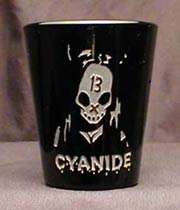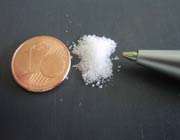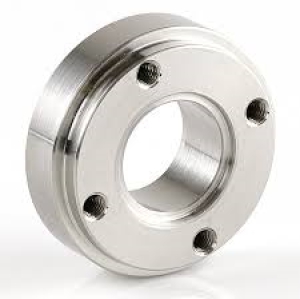English الکتروپولیش
cleaning, pretreatment & surface preparation
ELECTROPOLISHING
BY KENNETH B. HENSEL
ELECTRO POLISH SYSTEMS INC., MILWAUKEE; WWW.EP-SYSTEMS.COM
The electropolishing system smoothens, polishes, deburrs, and cleans steel, stainlesssteel, copper alloys, and aluminum alloys in an electrolytic bath. The processselectively removes high points on metal surfaces, giving the surface a high luster.
HOW IT WORKS
The metal part is immersed in a liquid media (electrolyte) and subjected todirect current. The metal part is made anodic (+) and a metal cathode (-), usually316L stainless steel or copper, is used. The direct current then flows from
the anode, which becomes polarized, allowing metal ions to diffuse throughthe film to the cathode, removing metal at a controlled rate. The amount ofmetal removed depends on the specific bath, temperature, current density, andthe particular alloy being electropolished. Generally, on stainless steel, 0.0005in. is removed in 1,500 amp-minutes per square foot. Current and time are twovariables that can be controlled to reach the same surface finish. For example,100 A/ft2 electropolished for 5 min is 500 amp-minutes; 200 A/ft2 for 21/2 minis 500 amp-minutes. Both pieces of metal would have about the same surfaceprofile. Current densities of 90 to 800 A/ft2 are used in this process dependingupon the part to be polished and other parameters. Electropolishing times varyfrom........
برای خواندن ادامه مطلب به سایت نویسنده مقاله مراجعه فرمایید.
ENGLISH - غیر فسفاتی - زیر سازی فلز برای پوشش
cleaning, pretreatment & surface preparation
NON-PHOSPHATE TRANSITION METAL
COATINGS
BY BRUCE DUNHAM AND DR. DAVID CHALK, DUBOIS CHEMICALS,
SHARONVILLE, OHIO
INTRODUCTION
Traditional iron phosphate and zinc phosphate conversion coatings havebeen used for more than a century as pretreatments for painting over a varietyof metals. These “legacy” phosphate pretreatments have served well; however,environmental regulations restricting phosphate discharge, increasedphosphate and zinc costs, and higher corrosion-resistance requirements have provided impetus for the development of non-phosphate alternatives. Duringthe evaluations of the various technologies, it was discovered that these newnon-phosphate pretreatment conversion coatings conferred significant costsavings and operational benefits along with their promised decreased environmentalimpact.Considered new and experimental in the New Millennium........
ادامه مقاله در سایت جلاپردازان پرشیا
ENGLISH-تمیز کاری فلز
cleaning, pretreatment & surface preparation
METAL CLEANING
BY ROBERT FARRELL AND EDMUND HORNER
HUBBARD-HALL INC., WATERBURY, CONN.; WWW.HUBBARDHALL.COM
Simply stated, the function performed in metal cleaning is removal of material,collected in the previous operations, from the metal’s surface to prepareit for subsequent operations.Cleaning metals involves not only the selection of the type(s) of cleaners,
but also the proper cleaning cycle and process equipment necessary to generateacceptable parts at a given rate (parts/hour).
An equation for such a cleaning operation may be illustrated as follows:Process Equipment + Process Cycle + Cleaner(s) = Acceptable Parts/HourEach of the terms in the equation shares the burden in providing acceptableparts at a given rate for an economical operation. The equation also notes thatin certain operations more than one cleaner may be required, as per a line forelectroplating.
Process equipment is the equipment selected—rack line, barrel line, spiralwasher, ultrasonic...
ادامه مطلب در سایت جلاپردازان پرشیا
شات بلاست با دانه های شیشه ای در آبکاری -ENGLISH
cleaning, pretreatment & surface preparation
IMPACT BLASTING WITH GLASS BEADS
BY ROBERT C. MULHALL AND NICHOLAS D. NEDAS
POTTERS INDUSTRIES INC., VALLEY FORGE, PA.; WWW.POTTERSBEADS.COM
Glass beads were originally used for decorative applications. Their use as a mediumin impact blasting came about largely as a result of the aerospace buildup ofthe 1950s. At that time, a need developed for multipurpose media that combinedthe advantages of coarse, organic, metallic, and fine angular abrasives. Table Ishows a comparison of glass beads with other impact abrasives for cleaning,
finishing, peening, and deburring applications.Impact blasting with glass beads is well placed to satisfy demands of the 1990sfor an energy-efficient and environmentally acceptable method of metal finishing.When properly controlled....
ادامه مقاله در سایت جلاپردازان پرشیا
پوشش دادن به روش غوطه وری -ENGLISH
coating materials and application methods
DIP COATING
BY THOMAS C. JONES
HENKEL SURFACE TECHNOLOGIES, MADISON HEIGHTS, MICH.
Dip application of a protective coating involves simply immersing a workpieceinto a suitable tank containing the coating material, allowing the part to drainafter withdrawal, and force drying or baking the wet coating to achieve thefinish. Dip coatings are used in many industries for both primer and one-coatfinishes.Thorough cleaning of parts is essential prior to dipping. For optimum quality,a phosphate conversion coating is also recommended.
BENEFITS
Simplicity: Manpower and equipment requirements are minimal. The process iseasily automated.Low Cost: Paint utilization should be relatively high (e.g., greater than 90%transfer efficiency) on properly operated systems, since nonused paint (drainage)is mostly recovered and returned to the system.Ease of Control: Minimally skilled operators can maintain solids, viscosity, andother factors for acceptable application properties.Good Coverage: Except for air bubbles or pockets....
ادامه مقاله در سایت جلاپردازان پرشیا
ENGLISH مقدمه ای بر سیستم های کاربردی رنگ
coating materials and application methods
INTRODUCTION TO
PAINT APPLICATION SYSTEMS
BY RON JOSEPH (1944-2011)
RON JOSEPH & ASSOCIATES INC., SAN JOSE, CALIF.
AND MICHAEL MURPHY
CONSULTANT, KILLIAN ENTERPRISES, VALLEY COTTAGE, N.Y.
A typical line for organic finishing of metals includes the following steps: precleaning,pretreatment, dry-off, primer application, flash-off and/or cure, andfinal cure. In some cases a primer or intermediate coating may not be used,and multiple applications of topcoat are not unusual. The combination of apigmented basecoat, often containing metallic flakes, and a final clear, lustroustopcoat is common today.
PRECLEANING
Procedures for preparation of metal parts for painting often include a precleaningstep. Removal of gross soils such as oil, grease, scale, weld spatter, lubricants,and other materials can be accomplished by mechanical means, with solvents,acids, or alkaline cleaning agents. Blasting, polishing, pickling, and solventdegreasing are described in the Metal Finishing Guidebook and Directory Issue. Whilethe purpose of precleaning is to remove the contaminants from the surface, thisprocess in and of itself does not provide any protection to the metals.
PRETREATMENT
The term pretreatment refers to a combination of chemical cleaning and conversioncoating. The purpose of a conversion coating is twofold. It improves corrosionresistance and provides a surface more accepting of the organic coating,subsequently enhancing adhesion...
ادامه مقاله در جلاپردازان پرشیا
پوشش پودری با ربات - ENGLISH
coating materials and application methods
POWDER COATING WITH ROBOTS
AND DENSE PHASE TECHNOLOGY—A
CRITICAL BLEND OF ADVANCED
TECHNOLOGIES
BY JOHN BINDER, MARKETING MANAGER, NORDSON POWDER COATING
SYSTEMS, NORDSON CORP., AMHERST, OHIO
The efficiencies of robotics designed specifically for painting—coupled withadvances in powder coating application and delivery technology through theuse of dense phase technology guns, pumps and controls—provides greater productivity,higher repeatability and savings in daily powder coating operations.There was a time when powder coaters would adapt large welding robots topowder coating applications. The result was costly over-sized machines that didnot lend themselves well to powder booths or precise powder paint applications.Often the window or opening for the robot would need to be sized to accommodatethe robot’s painting motion. This caused higher than desired openbooth area and up-sized collectors to allow for the necessary booth airflows tocontain powder.Since then, robot technologies have progressed at a rapid pace. Today, there arerobots designed specifically for powder painting that are smaller, more cost effectiveand more precise with advanced part identification and controls that communicatebetween the powder application equipment and ........
ادامه مقاله در سایت جلاپردازان پرشیا
رسوب دهی شیمیایی بخار
رسوب دهی شیمیایی بخار
مقدمه
(CVD: Chemical Vapor Deposition)
یک فرایند شیمیایی است که به منظور ایجاد یک لایه با کیفیت و با کارامدی بالا بر روی سطح استفاده می¬شود.این تکنیک اصولا توسط صنایع تولید کننده قطعات نیمه رسانا برای تشکیل یک فیلم نازک مورد استفاده قرار می¬گیرد. در این روش، پیش ماده ها تبخیر شده و وارد راکتور می شوند. در این راکتور مولکول های پیش ماده جذب سطحی زیرپایه می شوند. معمولا دمای زیرپایه در محدوده خاصی تنظیم می شود. مولکول های جذب شده، یا در اثر حرارت تجزیه می شوند و یا با گازها و بخارات دیگر واکنش داده و فیلم جامدی را روی زیرپایه تشکیل می دهند. واکنش هایی که روی سطح زیرپایه انجام می شود، واکنش های ناهمگن هستند. این فرآیند از انعطاف پذیری بالایی برخوردار است و برای ساخت بسیاری از مواد مانند فلزات، مواد {{نیمه رسانا}} و سرامیک ها به کار می رود. فیلم های جامد تهیه شده می تواند آمورف، پلیکریستال و یا تک کریستال باشد. هم چنین می توان با تنظیم شرایط رشد، فیلمهای جامد با خواص منحصر به فرد تهیه کرد...
ادامه مقاله در سایت جلاپردازان پرشیا
معرفی پوشش آلیاژی نیکل-روی-فسفر الکترولس
معرفی پوشش آلیاژی نیکل-روی-فسفر الکترولس
Introduction of electroless deposition for nickel –zinc–phosphorous alloys
|
با توجه به مقاومت در برابر خوردگی بالا، کادمیوم به طور گسترده به عنوان یک لایه محافظ ضد خوردگی برای اجزای فولاد مورد استفاده در صنایع و تجهیزات مربوط به تولید انرژی، حمل و نقل، تولید تجهیزات شیمیایی، سازه های فلزی و غیره مورد استفاده قرار می گیرد. با این حال، به دلیل سمی بودن فلز کادمیوم و نمک های مربوطه آن و همچنین آزاد شدن مقدار زیادی هیدروژن طی فرایند آبکاری کادمیوم که باعث ایجاد آسیب های ناشی از شکنندگی اسید می شود (تردی هیدروژنی)، استفاده از این فلز چندان مناسب نیست. برای محافظت در برابر خوردگی پایه های فولادی، پوششهای آلیاژی Zn-Ni را می توان به عنوان جایگزین مناسب برای پوشش Cd در نظر گرفت. |
Due to high corrosion resistance, cadmium is used extensively as an anticorrosive protection layer for steel components used in energetics, transportation, chemical equipment production, metallic constructions, and so forth. However, cadmium plating presents major inconvenients due to metal toxicity and used salts as well as simultaneous discharge of hydrogen ions during the cadmiation process, making cadmiated parts susceptible of acid brittleness [1]. Zn–Ni alloys are considered as possible replacement for Cd coatings for corrosion protection of steel substrates[2]. |
|
تکنولوژی فعلی برای پوشش Zn-Ni شامل پوشش های قلیایی و اسیدی می باشد. ویژگی های پوشش آلیاژی Zn-Ni در مقایسه با روی معمولی، دارای مزایایی از قبیل مقاومت در برابر خوردگی و داشتن رسوبات (پوشش) سخت تری است. همچنین، حضور نیکل، عامل مقاوم به خوردگی خوبی برای پوشش می شود. با این وجود، آبکاری این چنین آلیاژهایی عموما به روش ترسیب دوتایی کم است و نتیجتا باعث افزایش مقدار Zn در رسوب نهایی می شود. با توجه به مقدار بالای روی در پوشش، این آلیاژها الکترونگاتیوتر از کادمیم هستند و از اینرو در هر محیط خورندهای سریعا حل می شوند. ترکیب نیکل معمولی در آلیاژ Zn-Ni 10-15٪ است و هرگونه افزایش بیشتر در ترکیب نیکل بر اساس استفاده از نسبت Ni / Zn بالاتر از حد پیش بینی در حمام است. تلاش برای کاهش ناهماهنگی در مورد آلیاژهای Zn-Ni، تلاشهایی از قبیل وارد کردن گونه های بی اثر در حمام و یا ایجاد آلیاژهای سه تایی انجام شده است. ژو و کییف اثر افزودن قلع را بر روی رسوب غیرمستقیم آلیاژ Zn-Ni بررسی کرده اند. نسبت نیکل با اضافه کردن مقدار کمی قلع از 6 تا 8 درصد افزایش یافته است. با این حال، مشاهده شده است که افزایش مقدار کمی نیکل در آلیاژ ویژگی های سد شوندگی Zn-Ni را بهبود نمی بخشد. |
The current technology available for Zn–Ni plating includes both alkaline and acid plating. Deposit characteristics of Zn–Ni as compared to the conventional zinc include benefits of extended corrosion resistance and significantly harder deposits. Also, the presence of nickel imparts a good barrier resistance to the coating. However, the electrodeposition of such alloys is anomalous in nature, with the co-deposition resulting in a higher amount of Zn in the final deposit. Due to the high zinc content in the deposit, these alloys are more electronegative than cadmium and hence dissolve rapidly in any corrosive environments. Typical nickel composition in the Zn–Ni alloy is 10–15%,and any further increase in nickel composition is based on using a higher-than-predicted Ni/Zn ratio in the bat. Attempts were made to decrease the anomaly in case of Zn–Ni alloys by either introducing inert species in the bath or by developing a ternary alloy. Zhou[] and Keefe []have studied the effect of tin additions on the anomalous deposition of Zn–Ni alloy. The nickel ratio increased from 6 to 8% with the addition of small amounts of tin. However, the observed small increase of Ni content in the alloy did not improve the Zn–Ni barrier properties[2]. |
|
در حال حاضر تقاضای مصرف کنندگان برای تولید پوشش های آلیاژیی سه تایی رو به افزایش است. برای این منظور با کمک عوامل کاهنده ای همچون هیپوفسفیت ها، بور، هیدرازین یا فرمالدهید، ممکن است به طور همزمان فلزات مختلف را در سیستم های سه گانه نوع Ni-Me-P یا Ni-Me-B، را کاهش داد (Me یک فلز دیگر علاوه بر Ni را نشان می دهد). با این وجود، برای تولید موفق فیلم های آلیاژی سه تایی، محدودیت هایی نیز وجود دارد. به عنوان مثال، در ابتدا نیکل باید قادر به ترسیب کاتالیستی باشد. در مرحله دوم، کاهش فلز دوم که در آلیاژ شرکت دارد، باید به خواص کاتالیزوری آن در ارتباط با فرایند کاهش وابسته باشد. تعدادی از فلزات را می توان به پوشش های آلیاژی اضافه کرد، به شرطی که آنها به راحتی قادر به کاهش یافتن باشند و حتی اگر خواص کاتالیزوری مربوط به فرایند کاهش را ندارند در مقابل کاتالیست های سمی هم نباشند (باعث مسمومیت کاتالیست نشوند). در مواردی که احیای فلز دشوار است، غلظت آن در آلیاژ نمیتواند به مقادیر بالا برسد (به عنوان مثالNi-Cr-P ). فلزاتی که سمهای کاتالیستی هستند و بطور فعال سرعت احیای نیکل را به طور فعال کاهش می دهند می توانند تا حدی که مانع قطع شدن رسوب دهی نشوند (غیر فعال شدن فعال) به وان اضافه شوند (بعنوان مثال Ni-Sn-P). |
There is at present an increased demand for the production of coatings of ternary alloys. With the help of hypophosphites, boron reducting agents, hydrazine, or formaldehyde, it is possible to achieve the simultaneous reduction of different metals in ternary systems of the type Ni-Me-P or Ni-Me-B, where Me represents another metal. There are limitations, however, to the successful production of ternary alloy films. Thus, for instance, in the first place nickel must be capable of being catalytically deposited. In the second place the reduction of the second metal which participates in the alloy must be dependent on its catalytic properties in relation to the reduction process. Quite a number of metals can be incorporated into alloy coatings provided they can easily be reduced and are not catalyst poisons, even if they do not possess the relevant catalytic properties in relation to the reduction process. In cases where the metal is difficult to reduce, its concentration in the alloy cannot reach high values (e.g., Ni-Cr-P) (1). Metals which are catalyst poisons and which actively slow down the reduction of Ni can be incorporated to an extent that will not interrupt the deposition (e.g., Ni-Sn-P) [3]. |
|
آبکاری آلیاژهای Ni ± Zn در طی دهه گذشته برای بسیاری از کاربردها مانند حفاظت از خوردگی فولاد در وسایل نقلیه بسیار مورد توجه بوده است. اخیرا نشان داده شده است که افزودن فسفر، بعنوان یک عنصر غیر فلزی در این آلیاژها می تواند ریزساختار آنها را در طول فرایند آبکاری تغییر دهد و مقاومت به خوردگی آنها را بهبود بخشد. با این حال، مطالعه الکتروشیمیایی آلیاژهای Ni ± Zn ± P تاکنون کامل نشده است. در سایر تحقیقات [8، 9] به ترسیب این آلیاژها با هیپوفسفیت به عنوان کاتالیزور و منبع فسفر در رسوب توجه شده است، زیرا فرایند الکترولس از طریق غوطه وری ساده قطعه در محلول وان آبکاری می تواند منجر به ایجاد یک لایه پوشش یکنواخت شود. این آلیاژها به عنوان پوشش محافظ مربوط به صنعت خودرو هستند. |
Electrodeposition of Ni±Zn alloys has attracted much interest over the past decade for many applications such as the corrosion protection of steel in vehicles. Recently, it was shown that the inclusion of phosphorus, a nonmetallic element, in these alloys can modify their microstructure during electrodeposition and improve their corrosion resistance. However, the electrochemical study of Ni±Zn±P alloys has still not been completely developed. Other investigations have been devoted to the electroless deposition of these alloys with hypophosphite as reducer and as source of phosphorus in the deposit, because it can be applied as a uniform layer by simple immersion in the plating solution. These alloys are of relevance to the automobile industry as protective coatings [4] . |
|
این مهمترین دلیلی است که چرا در دهه های اخیر مطالعات گسترده ای جهت آبکاری آلیاژی نیکل با غلظت بالا(70-90٪) و روی با غلظت (25-25٪) انجام شده است. در این غلظت های عنصری، اگر چه فیلم نازک پوشیده شده دارای خواص ضد خوردگی عالی است، اما نمی توان از آن به عنوان یک پوشش فدا شونده برای قطعات فولادی استفاده کرد. |
These are the main reasons why, in the last decades, intense studies develops normally, obtaining high concentrations of 70–90% nickel and zinc concentrations of 10–25% in the cathodic deposit. At these elemental concentrations, although the deposited thin film exhibits excellent anticorrosive properties, it cannot be used as a sacrificial coating for steel parts[1]. |
|
فیلم نازک Zn-Ni-P، حاصل از فرایند الکترولس به عنوان یک فیلم محافظ بر روی یک لایه فداشونده Zn گالوانیزه یا یا نیکل-روی در یک پوشش محافظ چند جزئی بر روی فولاد استفاده می شود. مزیت این فیلم محافظ، کاهش پتانسیل الکتروشیمیایی با فولاد زیر لایه (فولاد بعنوان بستر یا فلز پایه) خواهد بود. |
Electroless-deposited thin Zn–Ni–P film has been used as a barrier film on a galvanic Zn or Ni–Zn sacrificial layer in a multicomponent corrosion protective coatings on steel. The advantage of this barrier film would be a reduced electrochemical potential difference with the underlying steel [5]. |
|
مراجع 1- Constantin, I. (2014). Microstructural Characterization and Corrosion Behavior of Electroless Ni-Zn-P Thin Films. Journal of Metallurgy, 2014. 2- Veeraraghavan, B., Kim, H., & Popov, B. (2004). Optimization of electroless Ni–Zn–P deposition process: experimental study and mathematical modeling. Electrochimica acta, 49(19), 3143-3154. 3- Schlesinger, M., Meng, X., & Snyder, D. D. (1990). Electroless Ni-Zn-P films. J. Electrochem. Soc, 137(6), 1858-1859. 4- Bouanani, M., Cherkaoui, F., Cherkaoui, M., Belcadi, S., Fratesi, R., & Roventi, G. (1999). Ni–Zn–P alloy deposition from sulfate bath: inhibitory effect of zinc. Journal of applied electrochemistry, 29(10), 1171-1176. 5- Abdel Hamid, Z., Ghanem, W. A., & Abo El Enin, S. A. (2005). Process aspects of electroless deposition for nickel–zinc–phosphorous alloys. Surface and interface analysis, 37(10), 792-796. |
|
|
تهیه شده در واحد پژوهش و گسترش جلاپردازان پرشیا (JP) فروردین 96 |
Prepared by research and development unit of jalapardazan (JP) April 2018 |
برای مطالعه مقالات بیشتر از این شرکت به سایت این شرکت مراجعه نمایید
محصولاتی که در این مقاله مورد استفاده قرار گرفت
چگونگی مرگ موجودات زنده با سیانور
مرگ با سیانور !
! قابل توجه آبکاران محترم
سیانید

پتاسیم سیانید یک ترکیب معدنی با فرمول KCN می باشد. این ترکیب به صورت کریستال های بی رنگ است که بیشتر به شکر شباهت دارد و به شدت در آب انحلال پذیر می باشد.

اغلب KCN در معادن طلا برای استخراج، سنتزهای آلی و آبکاری مورد استفاده واقع می شود. البته این ترکیب کاربردهای کمتری نیز در جواهرسازی برای طلاکاری و زراندود کردن به طریق شیمیایی دارد.
KCN به شدت سمی می باشد. بلور جامد نمدار و مرطوب KCN مقادیر کوچکی از هیدروژن سیانید را به علت هیدرولیز آزاد می کند که بویی شبیه به مغز بادام تلخ دارد. البته هیچ کس نمی تواند این بو را استشمام کند. در واقع توانایی انجام این کار یک خصیصه ژنتیکی و ارثی به شمار می آید. KCN توسط حشره شناسان به عوان عامل شدیدا کشنده در...............
برای خواندن ادامه مطلب به سایت نویسنده مقاله مراجعه فرمایید.
مرجع : جلاپردازان پرشیا














